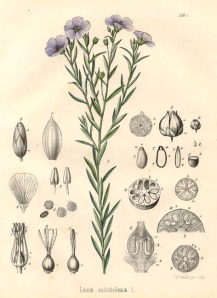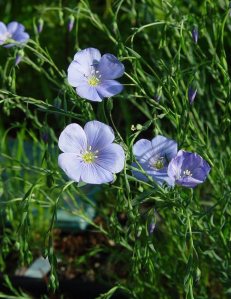
Image I

Image II
Botanical Name: Linium usitatissimum
Common name: Flax, Linseed, Flaxseed (Braun & Cohen, 2010, p. 444)
Family: Linaceae (Braun & Cohen, 2010, p. 444)
Parts used: Fixed oil derived from seed of plant (Braun & Cohen, 2010, p. 444),
Obtained by cold-pressing, highly susceptible to auto-oxidation, Encapsulated considered more stable (Braun & Cohen, 2010, p. 444)
Constituents:
- Alpha-linolenic acid (Most concentrated plant source of omaga-3s) (Braun & Cohen, 2010, p. 444)
- Phytoestrogenic lignans (Heinrich, Barnes, Gibbons & Williamson, 2012, p. 205)
Actions
- Cholesterol lowering properties (Heinrich et al., 2012, p. 205)
- Anti-inflammatory (Hoffmann, 2003, p. 57)
- Antithrombotic (Hoffmann, 2003, p. 57)
- Antiproliferative (Hoffmann, 2003, p. 57)
- Digestive system demulcent (Hoffmann, 2003, p. 506)
Indications (traditional)
- Upper respiratory tract infections
- Constipation
- Abdominal pain
- Urinary infection
- Topical demulcent for skin conditions
(Basch, Bent, Chao, Collins, Conquer, Costa, Dacey, Demark-Wahnefried, Frenkel, Giese, Hammerness, Harrison, Higdon, Hollenstein, Isaac, Nummy, Nguyen, Rusie, Grimes Serrano, Smith, Sweeney, Szapary, Thompson, Ulbricht, Vora, Weissner & Windsor, 2013, p. 21).
- Phytoestrogens have potential anti-cancer and anti-tumor properties in breast cancer, and may prove to be beneficial in future breast cancer prevention strategies (Bergman, Thompson & Dabrosin, 2007, Abstract).
Indications (contemporary)
- Chronic constipation (approved by German Commission E)
- Laxative damaged colon
- Gastritis and enteritis (Basche et al., 2013, p. 2)
- May play a role in cholesterol concentrations, studies have shown that flaxseed can reduce serum total and LDL cholesterol and raise serum levels of omega-3 fatty acids (Bloedon & Szapary, 2004, Abstract).
Preparation & Dosage
Flaxseed oil will degrade with exposure to heat, light and oxygen (Basche et al., 2013, p. 5).
As a laxative:
- 2-3 tablespoons of the seed mixed with ten times the amount of water
- 45g/day has also been noted as having laxative effects (Basche et al., 2013, p. 5).
Cautions
May interact with medications containing estrogens due to their phytoestrogen constituent (Basche et al., 2013, p. 3).
REFERENCE
Basch, E., Bent, S., Chao, W., Collins, J., Conquer, J., Costa, D., Dacey, C., Demark-Wahnefried, W., Frenkel, M., Giese, N., Hammerness, P., Harrison, M., Higdon, E., Hollenstein, J., Isaac, R., Nummy, K., Nguyen, Y., Rusie, E., Grimes Serrano, J., Smith, M., Sweeney, B., Szapary, P., Thompson, L., Ulbricht, C., Vora, M., Weissner, W., & Windsor, R. (2013). Flaxseed and flaxseed oil (Linum usitatissimum). Natural Standard Professional Monograph. Retrieved from: http://www.naturalstandard.com.ezproxy.think.edu.au/databases/herbssupplements/flaxseed.asp?#
Bergman, J. M., Thompson, L., Dabrosin, C. (2007). Flaxseed and its lignans inhibit estradiol-induced growth, angiogenesis, and secretion of vascular endothelial growth factor in human breast cancer xenografts in vivo. Clinical Cancer Research, 13(3), 1061-1067. Retrieved from: http://www.ncbi.nlm.nih.gov/pubmed/17289903?dopt=Abstract
Bloedon, L. & Szapary, P. (2004). Flaxseed and Cardiovascular Risk. Nutrition Review, 62(1), 18-27. Retrieved from: http://www.ncbi.nlm.nih.gov/pubmed/14995053?dopt=Abstract
Braun, L., & Cohen, M. (2010). Herbs & Natural Supplements: An Evidence based Guide (3rd ed.). Chatswood NSW: Churchill Livingstone/Elsevier.
Heinrich, M., Barnes, J., Gibbons, S., & Williamson, E. (2012). Fundamentals of Pharmacognosy and Phytotherapy (2nd ed.). Edinburgh: Churchill Livingstone/Elsevier.
Hoffmann, D. (2003). Medical Herbalism: The Science and Practice of Herbal Medicine. Rochester Vermont: Healing Arts Press.
Image I: NCBI (n.d.). Plant Resistance Genes. Retrieved from: http://prgdb.crg.eu/organism.php?name=Linum_usitatissimum
Image II: Linum usitatissimum L.. (2004). Linum usitatissimum L.. Retrieved from: http://www.missouriplants.com/Bluealt/Linum_usitatissimum_page.html